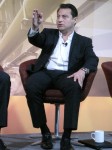Apr29
World’s Biggest Challenges are its Biggest Market Opportunities
Point: While many people wring their hands over seemingly insurmountable problems, entrepreneurs roll up their sleeves and work on solutions.
Story: Peter Diamandis, founder of the X PRIZE Foundation and Zero Gravity Corp., is particularly optimistic. Seeing what small teams can accomplish with today’s technologies, he sees limitless opportunities. “A Maasai tribesman in Kenya today has better mobile communications than President Reagan had 25 years ago. If they’re on a smartphone, they have access to more information than President Clinton did 15 years ago,” he says.
what small teams can accomplish with today’s technologies, he sees limitless opportunities. “A Maasai tribesman in Kenya today has better mobile communications than President Reagan had 25 years ago. If they’re on a smartphone, they have access to more information than President Clinton did 15 years ago,” he says.
These achievements don’t get as much attention as bad news, because our brains are wired to hone in on anything that could threaten our survival. But above the din of disasters and terrorist attacks are the facts that more people have been lifted out of poverty in the last 50 years than the previous 500. The cost of food is 1/13th what it was in 1870. Even those living below the poverty line in many countries today have access to a telephone, toilet, television, air-conditioning and a car — things that Andrew Carnegie or John D. Rockefeller couldn’t have dreamed of a century ago.
Moore’s law — the doubling of computing power for the same price every 12-24 months — is now showing up in other areas that are linked to computing power, including sensors, 3D printing and biotechnology. For example, 3D printers that cost $500,000 can now be bought for $1300, making them accessible to small companies and entrepreneurs.
Lower costs like that make it possible to offer much-needed but low-cost products to the “bottom billion” people in the lower rungs of the economic pyramid. For example, an estimated 1.1 billion people lack access to clean drinking water. But four billion of them are spending 30 cents a day for water, which makes clean water a $400 billion a year market, as inventor Dean Kamen points out. Kamen is in trials with a new water purifier that can turn any water (even polluted water, seawater or latrine water) into pure drinking water for less than .02 cents a liter).
Such innovations by entrepreneurs can solve the world’s biggest challenges.
“That’s my source of optimism. That and a realization I made early on that if there’s a problem, I’m going to solve it. Once you see the world that way, it’s a different place,” Diamandis said.
Action:
- Look at negative events as potential opportunities to create new products or services to prevent or mitigate the negative.
- Look past the sensationalized “bad news” to see the less-publicized march of positive trends in human development that create or expand markets for products and services.
- Consider how to leverage the rising spread of modern infrastructure (communications, utilities, and logistics) to access more suppliers, partners, and customers.
Sources and more information:
Peter Diamandis at the Innovation Summit at the Shell Technology Center Houston, January 9, 2013
Peter Diamandis’ book, Abundance: Why the Future Will Be Much Better Than You Think
Ted Greenwald, “X Prize Founder Peter Diamandis Has His Eyes on the Future,” Wired
Comments Off on World’s Biggest Challenges are its Biggest Market OpportunitiesEntrepreneurs, Innovation, Opportunity









